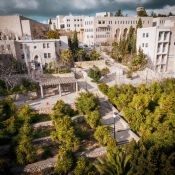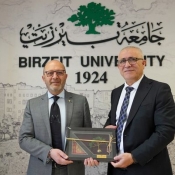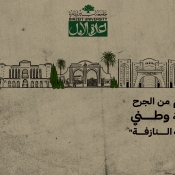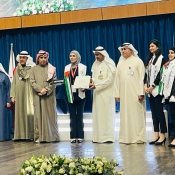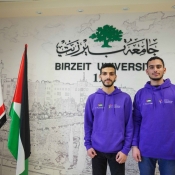First "Palestinian Prisoners' Week" held at Birzeit University
The Student Council of Birzeit University recently held a week to commemorate Palestinian prisoners held by Israel, between 4 and 9 October 1997. The week focused on raising awareness of the university community of the situation of the over 4,000 Palestinians currently being held in Israel, with particular emphasis on 36 Birzeit student detainees. The event was the first of its kind at the university and was a result of the increased tension concerning the issue of Palestinian prisoners and the recent detention of hundreds of Palestinians following suicide bombings in Jerusalem this summer.
The impetus for the week came from coordination by all faction representatives on the student council who felt that students should be more involved in supporting efforts to free Palestinian political prisoners. As the general conditions of prisoners worsens and the number of political prisoners continues to grow, students believe that it is time to make themselves heard in this issue.
"Students play an integral role in the development of society and it is our responsibility to push forward that development," stated Farid Adib Kaddoura, a member of the Birzeit Student Council and one of the main coordinators of the event. "The students of Birzeit Univeristy before us have set an example for us, that we were the main avenue to struggle against any sort of oppression during the occupation, and we want to continue this tradition. In the past, it has always been students who have been at the forefront of any fight for the respect of human rights. We need to make all students more aware of what is happening in society, to understand the difficulties of those who are in prison, and not to forget them. We need to see what we can do for our brothers in prison."
"The general feeling amongst Palestinians these days is that the people who have struggled for our rights are being forgotten and overlooked in the negotiations. Nothing is really being done for our prisoners or our martyrs and we felt that the least we could do is to raise this issue. We decided that the first step was to offer support to our political prisoners and to the families of detainees, as well as those who have been released. In the past few months, we have not heard any good news on this issue. Israel is slowly killing our people's spirit in this way and no one is paying attention. When someone gets out of prison, their health is very bad, their mental state is very bad, and their family has been severely affected by the absence of a family member. We thought that getting students involved in the issue through different activities would be a start in raising awareness."
The program for the week included a walk-through model of an Israeli prison, a photo exhibition including images of students who have been arrested, and an exhibit of handicrafts made by Palestinians during their imprisonment. Organisers tried to place emphasis not only on the political aspect of detention but also the cultural to make it more attractive to people who are not normally involved in politics and to involve as many students as possible.
A replica of an Israeli prison tent was constructed on campus to portray the conditions inside an Israeli prison and the various stages of imprisonment. The area was surrounded by barbed wire and "guarded" by a large poster of an armed Israeli soldier. Beside the poster was a list of the 36 Birzeit University students being held in Israeli prisons. Upon entering the tent, one is met by the "interrogator" who leads the detainee to the adjacent interrogation room. The room is scattered with symbolic forms of interrogation techniques often employed by the Israeli authorities. On one side is a black wall with images of various forms of interrogation framed by handprints in red. "The red handprints are intended to portray the blood of prisoners you see on prison walls after interrogation," stated Kaddoura. "Sometimes prisoners would write their names on the walls in their blood." Opposite the wall is the zinzan, or cell in which is used for solitary confinement and often interrogation sessions. The room is usually not more than two square meters, and is portrayed at the exhibition as a small, tight space separated by chains. Inside the zinzan, the viewer is met with the image of a man hanging from the ceiling with his arms and legs spread out, an interrogation position in which prisoners are held in for sometimes over 24 hours. The shabeh chair, pictured above right, is used in many forms of interrogation. The prisoner has his hands and legs tied tightly with a plastic rope and is placed on the chair in various positions either cut off circulation to the arms and legs or place various parts of the body under sever stress. The prisoner is told not to move, often being beaten if he does not obey the interrogator, and is left in the same position for prolonged periods of time.
To the right of the interrogation room is a long, narrow corridor, similar to what one would find connecting prison cells in sections. The corridor is completely black with red handprints on the side and is intended to symbolise the journey of a detainee from one space to the other, as prisoners are usually blindfolded when moving from one cell or room to another. The use of black throughout the exhibition was also intended to depict the oppressive feeling within the prison and within the prisoner himself. At the end of the corridor is the prison tent, pictured left, depicting a standard tent cell. The tent was constructed by students who have been detained by the Israeli authorities in the past and included a number of personal articles from their period of detention. Hanging on the walls of the tent are several slogans to release all Palestinian prisoners and a picture of Ayman Abu Khalil, a past member of the Student Council of Birzeit university who was arrested on 12 August 1994 and remains in prison.
The photographic exhibition included photos of detainees, young men being arrested by Israeli soldiers, and the life of prisoners inside jail. A number of photos displyed were taken by prisoners who were able to smuggle in a camera during the burning of Megiddo prison cell 5, in which over a hundred prisoners suffered severe injuries. The fire was started by Palestinian prisoners in an effort to draw attention to the severe conditions they were living in and to bring an end to their imprisonment. Photos included images of detainees with scorched faces, images of the prison cells and photos of prisoners who sustained injuries by prison wardens during riots that broke out during the fire. The exhibit included over 100 photographs.
Adjacent to the photo exhibit was a display of handicrafts made by Palestinian prisoners during their detention. The display included traditional handicrafts including embroidered pictures of popular national figures and verses from the Koran, and dozens of models of the Dome of the Rock. The items were made from articles found within the cells such as cardboard, toothpaste tubes and clothing. "Sometimes families are able to bring in things for their sons to decorate their craftwork, but it is generally very difficult to get anything into the prison," commented Kaddoura. "Very often, the Israeli authorities do not allow even food or clothing into the prison. They sometimes even forbid the Red Cross from bringing in clothing or blankets for the prisoners in the winter. But they work on these things despite the difficulty." Items in the exhibit were donated by the families of student detainees, who offered their support throughout the event.
In addition to the primary exhibits, additional activities were conducted to raise the awareness of the student community. This included a play entitled "The Time of Innocence" which focused on the plight of prisoners while they are in jail, the movie "Prisoner's Moon", a workshop with panelists from various human rights organisations discussing the situation of Palestinian political prisoners and efforts conducted on their behalf, and a reception in honour of the families of student detainees. The week concluded with a press conference in which Albert Aghazarian, Director of Public Relations at Birzeit University, addressed the issue of student detainees and the position and services offered by the University in this respect. Birzeit University's Human Rights Action Project follows the case of each student detained by both the Israeli and Palestinian Authorities and campaigns against the abuse of student's rights.

